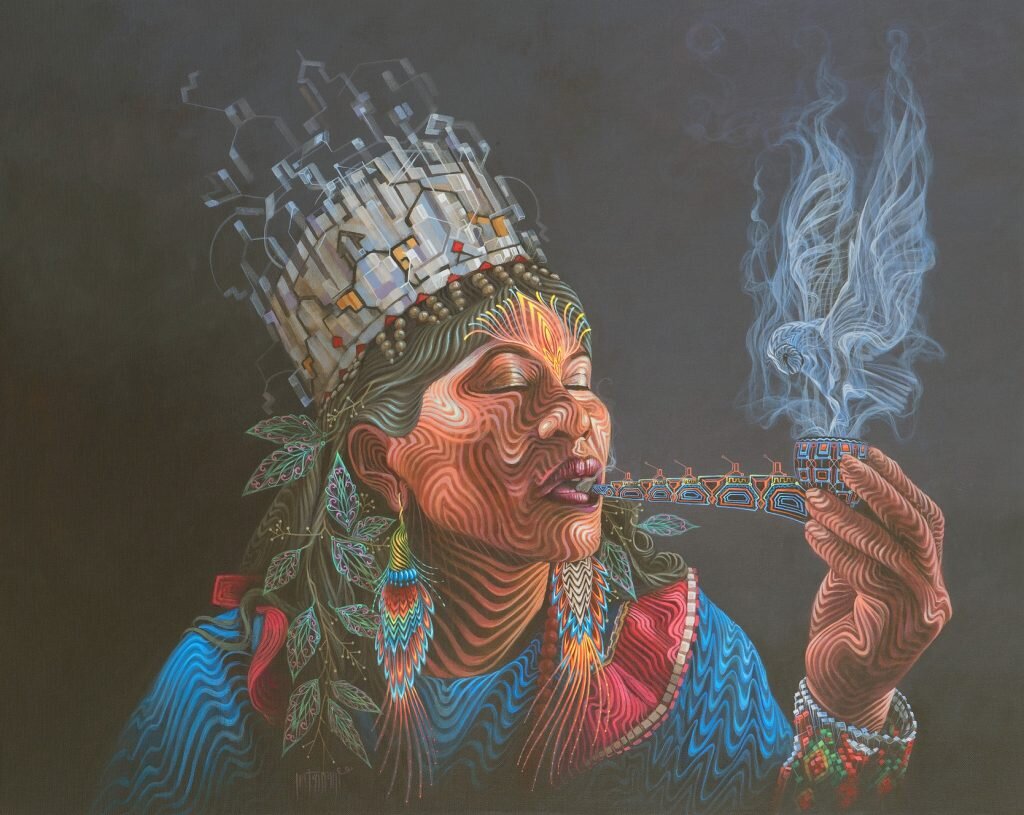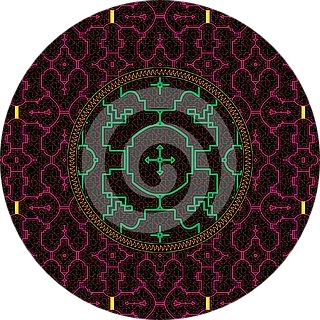
Artwork by Luis Tamani
Favaron, P., & Bensho, C. (2022). Rao bewa: los cantos medicinales del pueblo shipibo-konibo. Literatura: Teoría, Historia, Crítica, 24(2), 139–165.
El pueblo shipibo-konibo, asentado principalmente en las orillas del río ucayali, es uno de los más numerosos de la amazonía peruana. sus médicos tradicionales, llamados meraya (u onanya), son reconocidos en la región por sus grandes conocimientos y su honda tradición terapéutica. en el presente artículo, los autores proponen, con base en una sólida investigación etnográfica de muchos años y en sus propias experiencias en el campo de la medicina tradicional, una reflexión creativa, filosófica y poética en torno a los cantos medicinales de los sabios indígenas. debido a que ambos autores son comuneros empadronados de la comunidad nativa santa clara de yarinacocha y miembros (por afinidad y parentesco) de una familia shipiba que ha practicado la medicina tradicional y visionaria amazónica por muchas generaciones, el artículo no aplica metodologías eurocéntricas ni una escritura técnica. se opta, más bien, por hablar desde adentro de las propias racionalidades, epistemologías y ontologías del pueblo shipibo-konibo. los autores sostienen que este tipo de escritura permite dar cuenta de los saberes ancestrales con mayor fidelidad a la palabra de los sabios y expresar de una manera más profunda la rica herencia poética de los ancestros. esta perspectiva metodológica busca ser un aporte en la formación de una academia indígena intercultural.
//JavaScript source code
"use strict";
const nbSqMin = 40; // number of squares in geometrical mean of width height
const nbSqMax = 100; // length of square side sqWidthMin..50
const DHUE = 1; // integer 1-10 - hue change by step
const DLUM = 3; // 0.1 - 5 - lightness change by step
const SPEED = 1;
let canv, ctx; // canvas and context
let maxx, maxy; // canvas dimensions
let sqWidth, sqRad; // square side length, quarter of circle radius (1/2 sqWidth)
let grid;
let nbx, nby;
let hnbx, hnby; // number of squares in the half of the width, height of the canvas
let groups;
let listReachable;
// for animation
let events;
let colorMode;
// shortcuts for Math.
const mrandom = Math.random;
const mfloor = Math.floor;
const mround = Math.round;
const mceil = Math.ceil;
const mabs = Math.abs;
const mmin = Math.min;
const mmax = Math.max;
const mPI = Math.PI;
const mPIS2 = Math.PI / 2;
const mPIS3 = Math.PI / 3;
const m2PI = Math.PI * 2;
const m2PIS3 = (Math.PI * 2) / 3;
const msin = Math.sin;
const mcos = Math.cos;
const matan2 = Math.atan2;
const mhypot = Math.hypot;
const msqrt = Math.sqrt;
const rac3 = msqrt(3);
const rac3s2 = rac3 / 2;
//------------------------------------------------------------------------
function alea(mini, maxi) {
// random number in given range
if (typeof maxi == "undefined") return mini * mrandom(); // range 0..mini
return mini + mrandom() * (maxi - mini); // range mini..maxi
}
// - - - - - - - - - - - - - - - - - - - - - - - - - - - - - - - - - - - -
function intAlea(mini, maxi) {
// random integer in given range (mini..maxi - 1 or 0..mini - 1)
//
if (typeof maxi == "undefined") return mfloor(mini * mrandom()); // range 0..mini - 1
return mini + mfloor(mrandom() * (maxi - mini)); // range mini .. maxi - 1
}
// - - - - - - - - - - - - - - - - - - - - - - - - - - - - - - - - - - - - - -
function removeElement(array, element) {
let idx = array.indexOf(element);
if (idx == -1) throw "Bug ! indexOf -1 in removeElement";
array.splice(idx, 1);
} // removeElement
// - - - - - - - - - - - - - - - - - - - - - - - - - - - - - - - - - - - - - -
function randomElement(array) {
return array[intAlea(0, array.length)];
}
// - - - - - - - - - - - - - - - - - - - - - - - - - - - - - - - - - - - - - -
function arrayShuffle(array) {
/* randomly changes the order of items in an array
only the order is modified, not the elements
*/
let k1, temp;
for (let k = array.length - 1; k >= 1; --k) {
k1 = intAlea(0, k + 1);
temp = array[k];
array[k] = array[k1];
array[k1] = temp;
} // for k
return array;
} // arrayShuffle
//------------------------------------------------------------------------
function Square(kx, ky, color) {
/* constructor */
this.color = color ? color : `hsl(${intAlea(360)},100%,50%)`;
this.kx = kx;
this.ky = ky;
this.kxc = kx - hnbx;
this.kyc = ky - hnby;
this.xc = maxx / 2 + this.kxc * sqWidth; // center of square
this.yc = maxy / 2 + this.kyc * sqWidth;
} // Square
// - - - - - - - - - - - - - - - - - - - - - - - - - - - - - - - - - - - -
Square.prototype.fillSquare = function (evolColor) {
const side = sqWidth * 0.707;
const hSide = side / 2;
ctx.fillStyle = `hsl(${evolColor.hue}, 100%,${evolColor.lum}% )`;
ctx.beginPath();
ctx.arc(this.xc, this.yc, side, 0, m2PI);
ctx.fill();
ctx.strokeStyle = "#000";
ctx.lineWidth = 1;
ctx.stroke();
}; // Square.prototype.fillSquare
//------------------------------------------------------------------------
let animate;
{
// scope for animate
let animState = 0;
let listReachable;
let currCell, evolColor;
animate = function (tStamp) {
let tinit;
let event;
let neighGroups;
event = events.shift();
if (event && event.event == "reset") animState = 0;
if (event && event.event == "click") animState = 0;
window.requestAnimationFrame(animate);
tinit = performance.now();
do {
switch (animState) {
case 0:
if (startOver()) {
++animState;
evolColor = {};
evolColor.hue = intAlea(360);
evolColor.dhue = intAlea(2) ? DHUE : 360 - DHUE;
evolColor.lum = intAlea(40, 80);
evolColor.dlum = intAlea(2) ? -DLUM : DLUM;
evolColor.width = alea(0.5, 2.5);
evolColor.dWidth = 0.1;
evolColor = nextColor(evolColor);
}
break;
case 1:
currCell = grid[hnby][hnbx];
currCell.from = -1;
currCell.evolColor = evolColor;
listReachable = [currCell];
++animState;
case 2:
if (listReachable.length == 0) {
animState += 2; // finished !
break;
}
currCell = listReachable.shift();
// evolColor = currCell.evolColor;
++animState;
// break;
case 3:
currCell.group.forEach((cell) => cell.fillSquare(evolColor));
// make list of all neighbour groups
neighGroups = new Set();
currCell.group.forEach((cell) => {
cell.neighbours.forEach((neighCell) => {
if (!neighCell.evolColor)
// keep only undrawn cells;
neighGroups.add(neighCell.group);
}); // cell.neighbours.forEach
}); // currCell.group.forEach
if (neighGroups.size == 0) {
// no neighbours available
--animState; // go back and fetch in listReachable
break;
}
// put those groups in a random order
neighGroups = arrayShuffle([...neighGroups]); // change into Array
// prepare future color
evolColor = nextColor(evolColor);
// attribute new color to all neighbours (all cells of all neighbour groups)
neighGroups.forEach((group) => {
group.forEach((cell) => {
cell.evolColor = evolColor;
cell.from = -1;
}); // group.forEach
}); // neighGroups.forEach
for (let k = 1; k < neighGroups.length; ++k) {
listReachable.push([...neighGroups[k]][0]); // push 1 cell of every group - but first
}
currCell = [...neighGroups[0]][0];
break;
} // switch
} while (
(animState == 2 || animState == 3) &&
performance.now() - tinit < SPEED
);
}; // animate
} // scope for animate
//------------------------------------------------------------------------
function createGrid() {
let kx1, ky1, cell;
grid = [];
for (let ky = 0; ky < nby; ++ky) {
grid[ky] = [];
for (let kx = 0; kx < nbx; ++kx) {
grid[ky][kx] = new Square(kx, ky);
} // for kx
} // for ky
// calculate neighbours
for (let ky = 0; ky < nby; ++ky) {
for (let kx = 0; kx < nbx; ++kx) {
cell = grid[ky][kx];
cell.neighbours = [];
ky1 = ky - 1; // neighbour side 0
if (ky1 >= 0) cell.neighbours[0] = grid[ky1][kx];
kx1 = kx + 1; // neighbour side 1
if (kx1 < nbx) cell.neighbours[1] = grid[ky][kx1];
ky1 = ky + 1; // neighbour side 2
if (ky1 < nby) cell.neighbours[2] = grid[ky1][kx];
kx1 = kx - 1; // neighbour side 3
if (kx1 >= 0) cell.neighbours[3] = grid[ky][kx1];
} // for kx
} // for ky
// create groups
for (let ky = 0; ky < nby; ++ky) {
for (let kx = 0; kx < nbx; ++kx) {
cell = grid[ky][kx];
if (cell.group) continue;
cell.group = new Set([cell]); // myself
addToGroup(cell.group, hnbx - cell.kxc, cell.ky);
addToGroup(cell.group, cell.kx, hnby - cell.kyc);
addToGroup(cell.group, hnbx - cell.kxc, hnby - cell.kyc);
addToGroup(cell.group, hnbx + cell.kyc, hnby + cell.kxc);
addToGroup(cell.group, hnbx + cell.kyc, hnby - cell.kxc);
addToGroup(cell.group, hnbx - cell.kyc, hnby + cell.kxc);
addToGroup(cell.group, hnbx - cell.kyc, hnby - cell.kxc);
} // for kx
} // for ky
} // createGrid
//------------------------------------------------------------------------
function addToGroup(group, kx, ky) {
if (kx < 0 || ky < 0 || kx >= nbx || ky >= nby) return; // out of grid, do not add
group.add(grid[ky][kx]);
grid[ky][kx].group = group;
} // addToGroup
//------------------------------------------------------------------------
function nextColor(evolColor) {
let hue = evolColor.hue;
let dhue = evolColor.dhue;
let lum = evolColor.lum;
let dlum = evolColor.dlum;
let width = evolColor.width;
let dWidth = evolColor.dWidth;
let color;
switch (colorMode) {
case 0:
color = `hsl(${hue},100%,50%)`;
hue = (hue + dhue) % 360;
lum = 50;
break;
case 1:
color = `hsl(${hue},100%,${lum}%)`;
lum += dlum;
if (lum > 80) dlum = -mabs(dlum);
if (lum < 40) dlum = mabs(dlum);
break;
case 2:
color = `hsl(${hue},100%,${lum}%)`;
lum += dlum;
if (lum > 80) dlum = -mabs(dlum);
if (lum < 40) dlum = mabs(dlum);
hue = (hue + dhue) % 360;
break;
} // switch
width += dWidth;
if (width > 2.5) dWidth = -mabs(dWidth);
if (width < 0.5) dWidth = mabs(dWidth);
return {
hue: hue,
dhue: dhue,
lum: lum,
dlum: dlum,
width: width,
dWidth: dWidth,
color: color
};
} // returnColor
//------------------------------------------------------------------------
function startOver() {
// canvas dimensions
maxx = window.innerWidth;
maxy = window.innerHeight;
canv.width = maxx;
canv.height = maxy;
ctx.lineJoin = "bevel";
ctx.lineCap = "round";
sqWidth = msqrt(maxx * maxy) / alea(nbSqMin, nbSqMax);
sqRad = sqWidth / 2;
hnby = mfloor(maxy / sqWidth / 2); // the full array has 2 * hnbx + 1 rows
hnbx = mfloor(maxx / sqWidth / 2);
nbx = 1 + 2 * hnbx;
nby = 1 + 2 * hnby;
if (nbx < 3 || nby < 3) return false;
ctx.clearRect(0, 0, maxx, maxy);
if (colorMode == undefined) colorMode = 2;
else colorMode = intAlea(3);
createGrid();
return true;
} // startOver
//------------------------------------------------------------------------
function mouseClick(event) {
events.push({ event: "click" });
} // mouseMove
//------------------------------------------------------------------------
//------------------------------------------------------------------------
// beginning of execution
{
canv = document.createElement("canvas");
canv.style.position = "absolute";
document.body.appendChild(canv);
ctx = canv.getContext("2d");
} // création CANVAS
canv.addEventListener("click", mouseClick); // just for initial position
events = [{ event: "reset" }];
requestAnimationFrame(animate);
// Credit: https://codepen.io/Dillo/pen/OJGbpqz



